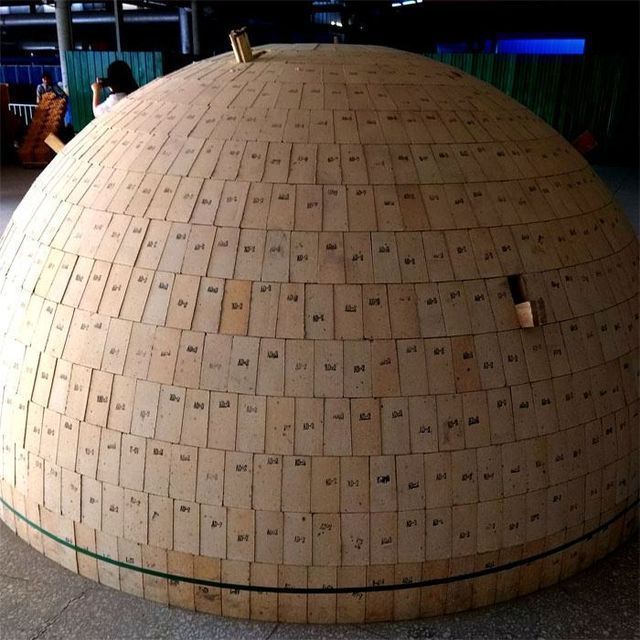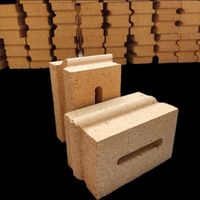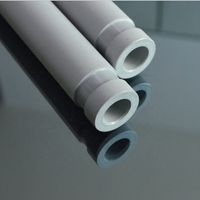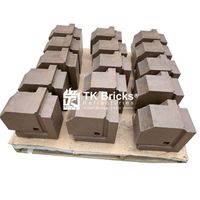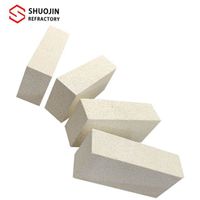High alumina curved bricks for hot blast furnace roof
- $200.00 / >=5 pieces
- 5 pieces
- Zhengzhou Huachen Refractory Co., Ltd.
- Henan, China
- Mr Danny Lv
Product Detail
| Silica content (%): | ≤27% | Load refractoriness: | ≥1500° |
| China Classification Society: | ≥49 MPa | shape: | brick |
| MgO content (%): | ≤0.1% | CrO content (%): | 0 |
| Apparent porosity: | ≤24% | Refractoriness: | ≥1790° |
| port: | Tianjin (Xingang) | Refractoriness (degrees): | Ordinary (1580° |
| Al2O3 content (%): | ≥65% | brand: | Brilliance |
| model: | High carbon steel SK | Origin: | Henan, China |
| Supply capacity: | 200 tons per month | CaO content (%): | ≤0.5% |
| Package preview: | Material: | Aluminum oxide | |
| Silicon carbide content (%): | 0 | payment terms: | L/C, Western Union, T/T, MoneyGram |
| Packaging Details: | wooden box |
Product Description

High-alumina bricks are made of bauxite clinker as raw material, adding a certain amount of bonded clay, and an aluminum-silicon refractory product with an Al2O3 content of more than 48%. The production process of high-alumina bricks is basically the same as that of high-quality multi-stubble clay bricks. The difference is that there is a classification and sorting process before clinker crushing and a post-screening iron removal process.
High-alumina bricks change the ratio of Al2O3/SiO2 on the basis of clay bricks and increase the content of Al2O3, so the refractoriness and high-temperature mechanical strength are better than clay bricks. The chemical properties of high alumina bricks tend to be neutral, so they are more resistant to acid and alkali slag erosion than clay bricks and silica bricks.
Therefore, the parts that used silica bricks or clay bricks in various thermal equipment can be replaced by high alumina bricks. Using high alumina bricks instead of clay bricks and silica bricks can improve the service life of thermal equipment.But high alumina bricks are more expensive than clay bricks. Therefore, it is not necessary to use high alumina bricks where clay bricks can meet production requirements.
crafting process
Material selection—>crushing—>sieving—>ingredients—>stirring—>preforming—>drying—>sintering
application
hot air stove top
VIEW MORE
Related Products
-
BN boron nitride coating for casting materials, aluminum casting coating, die-casting release coating
Product Description Boron nitride coating is a non-toxic, non-polluting and environmentally friendly material that is non-stick and does not penetrate molten metal. It can fully protect the surface of refractory containers that are in direct contact with molten metal and slag, greatly extending the.... -
200 mesh bauxite powder for high temperature kiln in refractory production
Brand Name: Dongtian sample: free size: Size customization Bulk Density: >3.0 MgO content (%): 0.1 Sales Unit: Single item shape: powder Origin: Henan, China Iron Oxide:... -
Good impact resistance cordierite mullite ceramic tube refractory ceramic tube
Place of origin: Jiangsu, China Packaging details: wooden box or carton Refractory degree (degree): Ordinary (1580° Material: cordierite mullite Al2O3 content (%): 48.94 model: HKCD63 Silica content (%): 41.62 Mailing method: DHL, Fedex, UPS or others Key words: Cordierite mullite ceramic tube...... -
China Made Fire Resistant Insulation Material Vermiculite Fire Resistant Insulation Board Vermiculite Board
Packaging details: Fumigated wooden pallet with exterior stretch film and steel foot straps. Refractory degree (degree): Ordinary (1580° brand: cloud field Fire resistance temperature: 1150℃ Silicon carbide content (%): ~ model: vermiculite slab CaO content (%): ~ Supply capacity: Daily output...... -
Low price refractory clay bricks refractory bricks refractory heating furnace boiler kiln industry refractory materials
Supply capacity: 3000 tons of refractory bricks per month color: yellow Operating temperature: 1250-1350 size: client needs Packaging details: 1.International standard airworthy export packaging. 2. Wooden pallets. 3. Wooden/bamboo box (box). 4. Further packaging information will be based on...... -
Silicon Carbide Ceramic Silicon Nitride Si3N4/Sialon Riser Tube for Aluminum Casting
Material: Silicon carbide (SiC) CaO content (%): 0.01 Thermal Conductivity: 0.08W/(meter*K) Refractory degree (degree): Ordinary (1580° Packaging details: The silicon carbide rod has bubble paper inside and a wooden box outside. Moh's hardness: 80-90HRA Magnesium oxide content (%): 0.01 model:...... -
Refractory Bricks Clay Bricks BBQ Pit Price for Glass Oven and Pizza Oven
application: Insulation, fire-resistant lining Ferric oxide%: Maximum 2.5 Load softening temperature (0.2MPa)℃: 1350 minutes Certificate: ISO BV Refractory degree (degree): Ordinary (1580° Bulk density g/cm3: 2.3-2.4kg/cubic meter Al2O3 content (%): 38-42% Silica content (%): 50%~65% port: Qingdao,.... -
230x114x65MM size refractory interlocking clay refractory bricks for kiln
brand: Lecter High temperature cone equivalent Orton cone: 31-32 Package preview: Al2O3 content (%): 36.2 Titanium dioxide(%): 3 Bulk density (kg/m3): 2100-2200 port: Qingdao Na2O+K2O+Li2O(%): 0.5 Material: flint clay Apparent porosity(%): 22-24 Refractoriness (degrees): Ordinary (1580° Supply...... -
High quality lightweight heat insulating refractory bricks jm 23/26/28/30 heat insulating refractory bricks
color: white Operating temperature: 1260 degrees Celsius Aluminum oxide: 35%~40% CaO content (%): 0.01 port: Qingdao Port, Lianyungang application: industrial furnace Material: Mullite Magnesium oxide content (%): 0 shape: brick brand: Shuo Jin Cr2O content (%): 0 payment terms: L/C, Western Union,.... -
Refractory arch brick for pizza oven
Certificate: ISO9001:2000 Cr2O content (%): - shape: brick size: 230x116x65/75 mm Silicon carbide content (%): - model: SK34 Refractoriness (degrees): Ordinary (1580° Material: refractory clay Supply capacity: 5000 tons per month CaO content (%): - Origin: Shandong Province, China Silica content......
